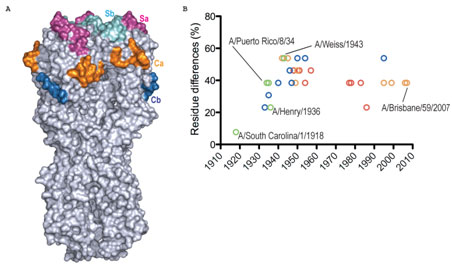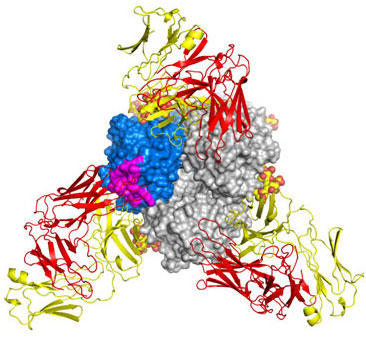
The emergence of the 2009 H1N1 influenza pandemic, also known as the "swine flu", marks the first human flu pandemic in 40 years and has caused significant human infection and mortality globally (1). The emergence of the 2009 H1N1 flu marks the first time that an influenza pandemic was triggered by a virus carrying the same hemagglutinin (HA) subtype as circulating seasonal strains. In contrast, all prior pandemics were caused by the rise of a novel influenza strain with a different hemagglutinin subtype. And unlike seasonal flu that usually affects the elderly most severely, swine flu has been primarily targeting people under the age of 65, implying some age-related pre-existing immunity (2,3).
The crystal structure of the HA ectodomain from the pandemic virus A/California/04/2009 was determined to 2.6 Å resolution using data collected at SSRL beam line 9-2. Comparative analysis of its antigenic structure with other HAs suggests that it shares conserved epitopes with H1N1 viruses from the 1918 influenza pandemic. The similarity of the antigenic surface in seasonal human H1 viruses gradually decreases over time since 1918 to ~1930, with the accumulation of amino acid mutations and addition of glycosylation sites. The similarity of the Sa antigenic site, in particular, of the 2009 H1N1 virus with the early human H1 viruses suggests the molecular basis for the age-related pre-existing immunity, whereas the distinct antigenic properties of the later human viruses provide for a naïve population susceptible to pandemic infection.

This analysis is strongly complemented by a crystal structure of the 1918 H1 hemagglutinin in complex with antibody 2D1 Fab fragment, determined at 2.8 Å resolution. Antibody 2D1 cross-neutralizes the 1918 and 2009 pandemic viruses in vivo (4), and binds to the Sa antigenic site which is nearly identical in the 1918 and 2009 pandemic viruses. These structures clearly illustrate the high degree of conservation in the Sa site between the 2009 H1N1 flu and the hemagglutinins of H1N1 viruses found during the first decades of the 20thcentury. Exposure to older viruses circulating from 1918 through the 1930's or 1940's likely elicited 2D1-like antibodies that can cross-react with the 2009 virus HA. As a result, the individuals exposed to these viruses, now over the age of 65, have some protection from swine flu by antibodies originally elicited more than 50 years ago, providing an explanation for the age-related infection and mortality rates observed in the current H1N1 pandemic.
- World Health Organization, http://www.who.int.
- Itoh, Y., et al. In vitro and in vivo characterization of new swine-origin H1N1 influenza viruses. Nature 460, 1021-1015 (2009)
- Hancock, K., et al. Cross-reactive antibody responses to the 2009 pandemic H1N1 influenza virus. N. Engl. J. Med. 361, 1945-1952 (2009)
- Krause, J.C., et al. Naturally Occurring Human Monoclonal Antibodies Neutralize both 1918 and 2009 Pandemic Influenza A (H1N1) Viruses. J. Virol. 84, 3127-3130 (2010)
Xu, R., Ekiert, D.C., Krause, J.C., Hai, R., Crowe, J.E. Jr, Wilson, I.A. Structural Basis of Preexisting Immunity to the 2009 H1N1 Pandemic Influenza Virus. Science 328, 357-360 (2010).




